Sanxingdui Museum is located in Guanghan City, at the northeast edge of the Sanxingdui Ruins, approximately 40 kilometers from Chengdu. This world-class archaeological museum has gained international acclaim for its extraordinary Bronze Age artifacts, innovative architectural design, and beautifully landscaped grounds that together create an unforgettable cultural experience.
Sanxingdui Museum Facts
- Name: Sanxingdui Museum
- Address: Duck River (Yazi River), West of Guanghan City, Sichuan Province
- Type: Historical Site Museum, National Archaeological Site Part
- Area: 1,000 acres
- Showcases: over 2,000 cultural relics
- Tickets: CNY 72. Trip.com discounts >>
- Opening Hours: 08:30-18:00
- Recommended Visiting Time: 2 hours
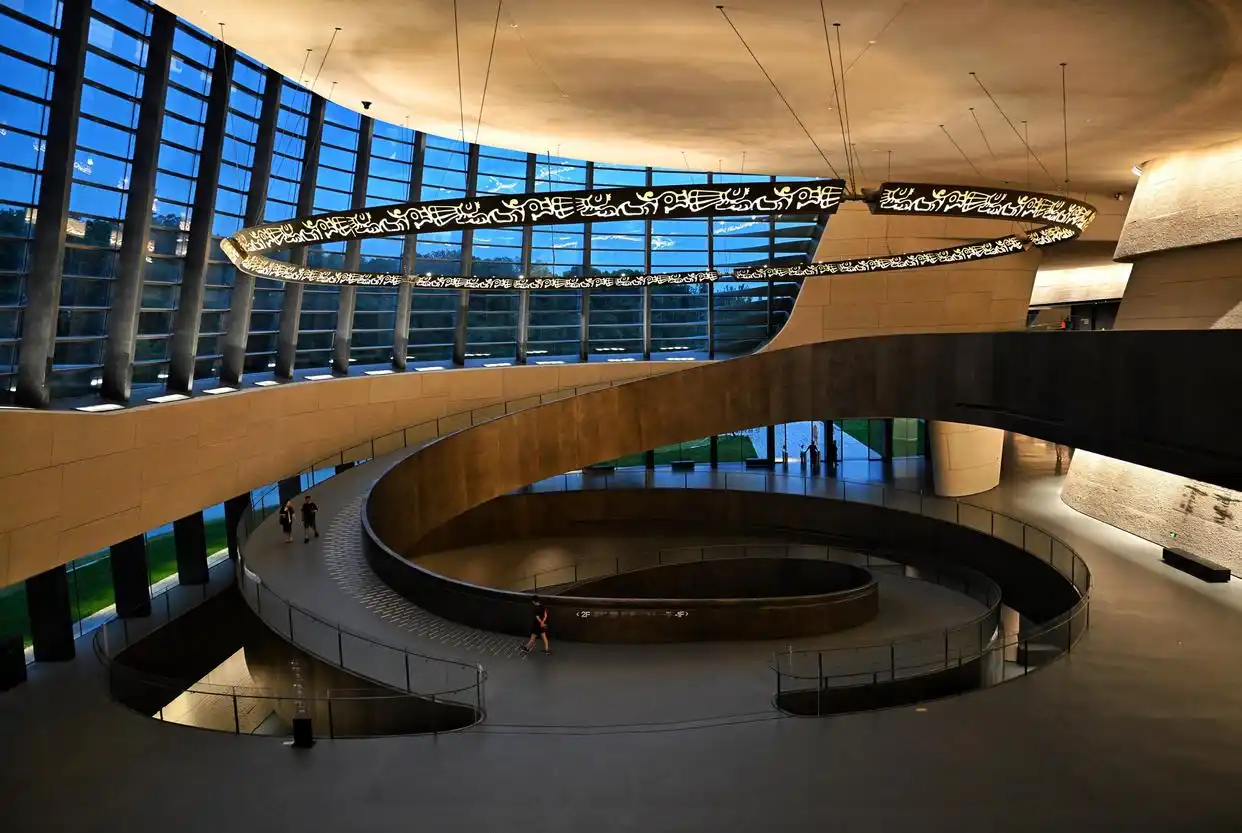
Named after three ancient earthen mounds along the Yazi River, the Sanxingdui site has yielded precious Bronze Age artifacts including gold masks, bronze trees, jade blades, and ivory carvings. This discovery not only marks the emergence of the brilliant Sanxingdui civilization but also stands as one of the greatest archaeological finds of the 20th century.The findings confirm the existence of the ancient Shu Kingdom (Sichuan) and push back Sichuan’s recorded history by over 2,000 years.
The museum preserves these discoveries through two main exhibition halls: the Original Hall (opened 1997) and the New Hall (opened 2023). Since 1993, the museum has organized global exhibitions, astonishing the world with these extraordinary cultural treasures of humanity.
Sanxingdui Museum History
The museum’s tale begins with a lucky accident in 1929, when a farmer digging an irrigation ditch uncovered jade pieces that would later be recognized as clues to China’s greatest archaeological discovery of the 20th century.
After decades of small-scale excavations, the big breakthrough came in 1986 when workers accidentally found two sacrificial pits containing:
- Mind-boggling bronze masks
- A 4-meter-tall bronze tree
- Golden staffs of unknown purpose
These finds were so extraordinary that China built a dedicated museum onsite, which opened in 1997 to display these “out-of-this-world” artifacts. The original museum quickly became a pilgrimage site for history lovers.
In 2023, a stunning new exhibition hall opened to accommodate more recent discoveries (including 6 new pits found in 2019-2022), making it now one of the world’s most advanced archaeological museums.
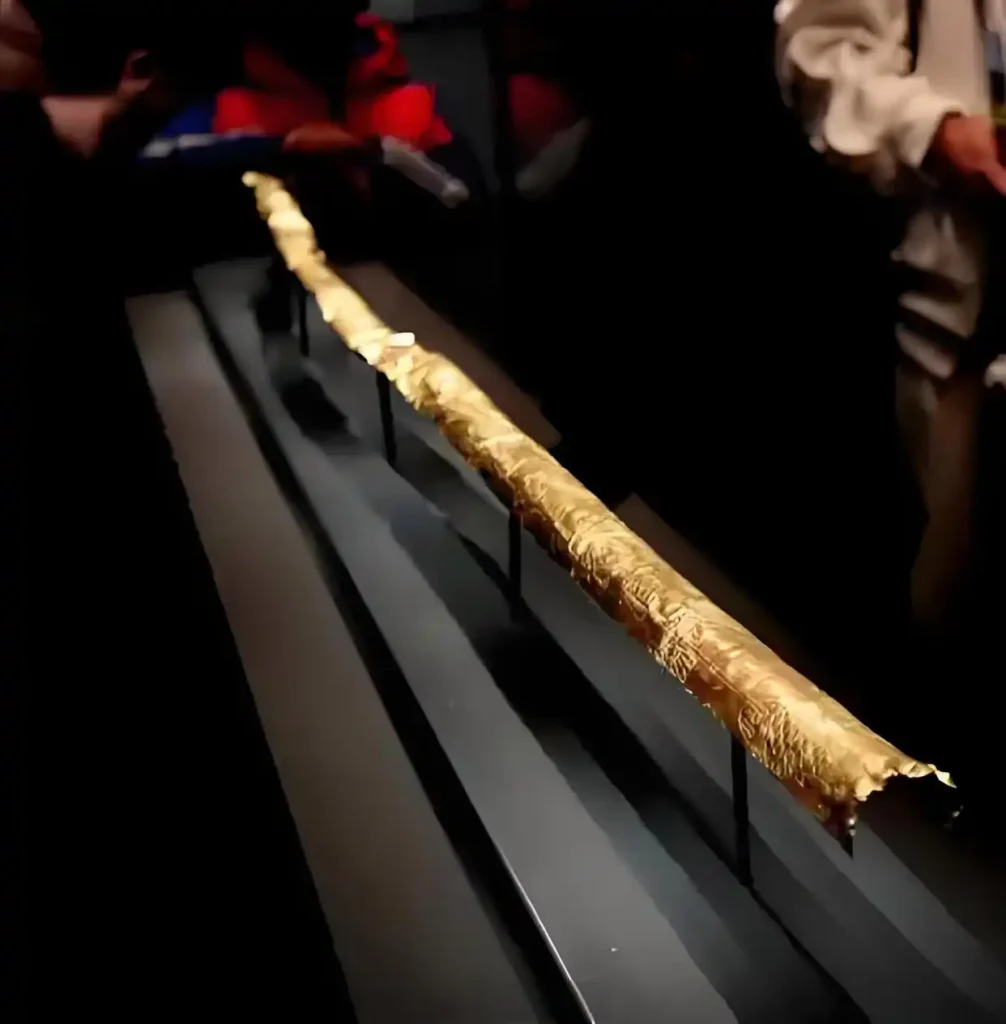
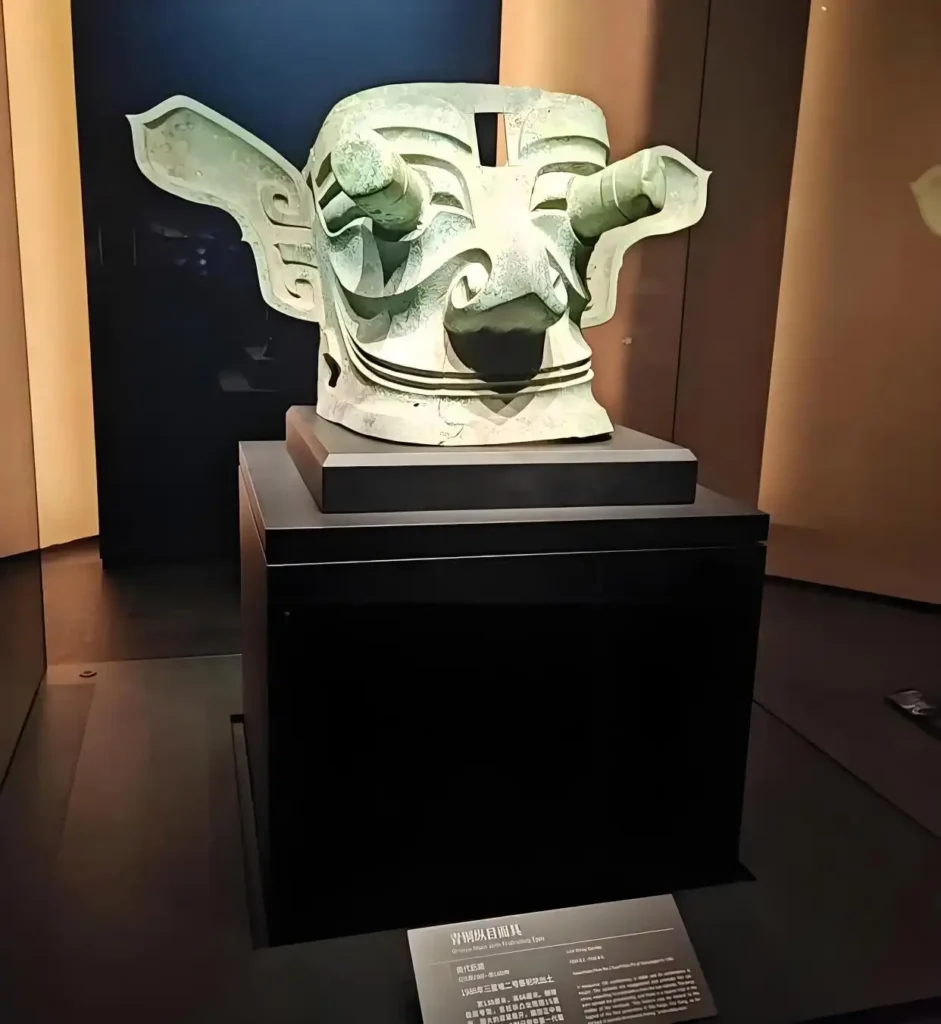
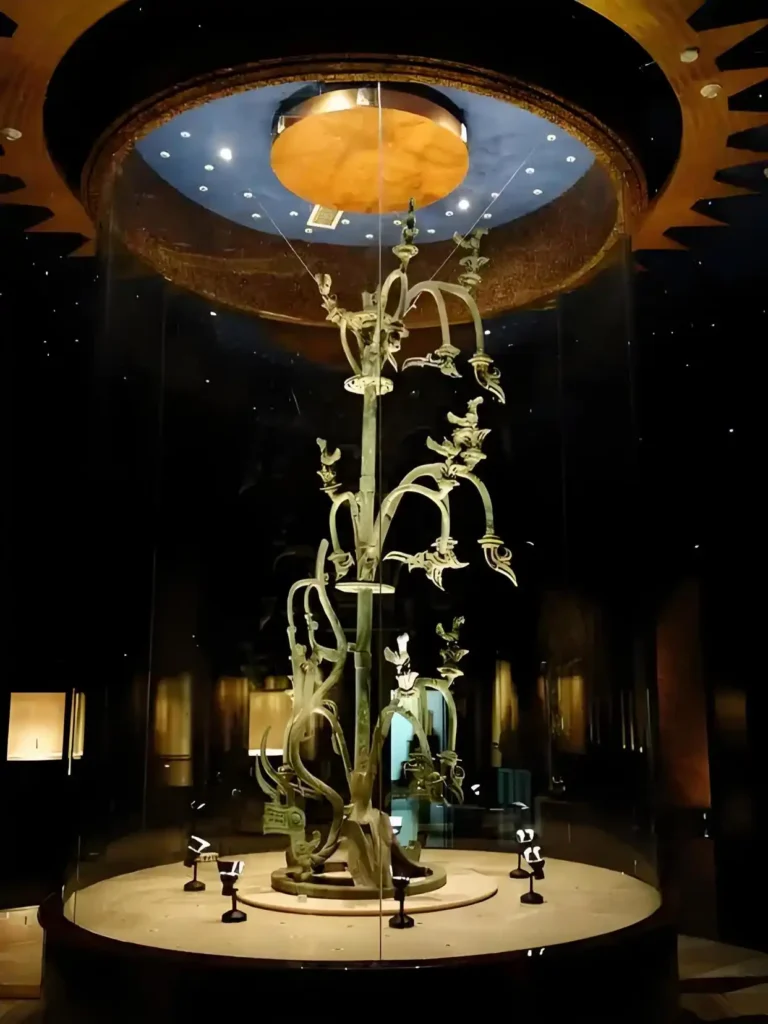
What are the Main Exhibits at Sanxingdui Museum
There are two exhibition halls in the museum complex: the main Exhibition Hall, which is the larger one displaying all the artifacts, and the Conservation Hall where visitors can observe live cultural relic restoration work. The Exhibition Hall contains three permanent exhibition sections:
1. Pursuing Dreams in the Century
Location: 1st Floor Exhibition Area
The discovery began in 1929 with jade artifacts found at Sanxingdui. In 1980, the “Sanxingdui Culture” was officially named. The excavations culminated in 2019 with six new sacrificial pits, proving how this site “after sleeping for millennia, awakens to astonish the world.”
Artifacts on Display at Pursuing Dreams in the Century:
1. The Shang Dynasty stone bi (ritual disc) unearthed in 1929.
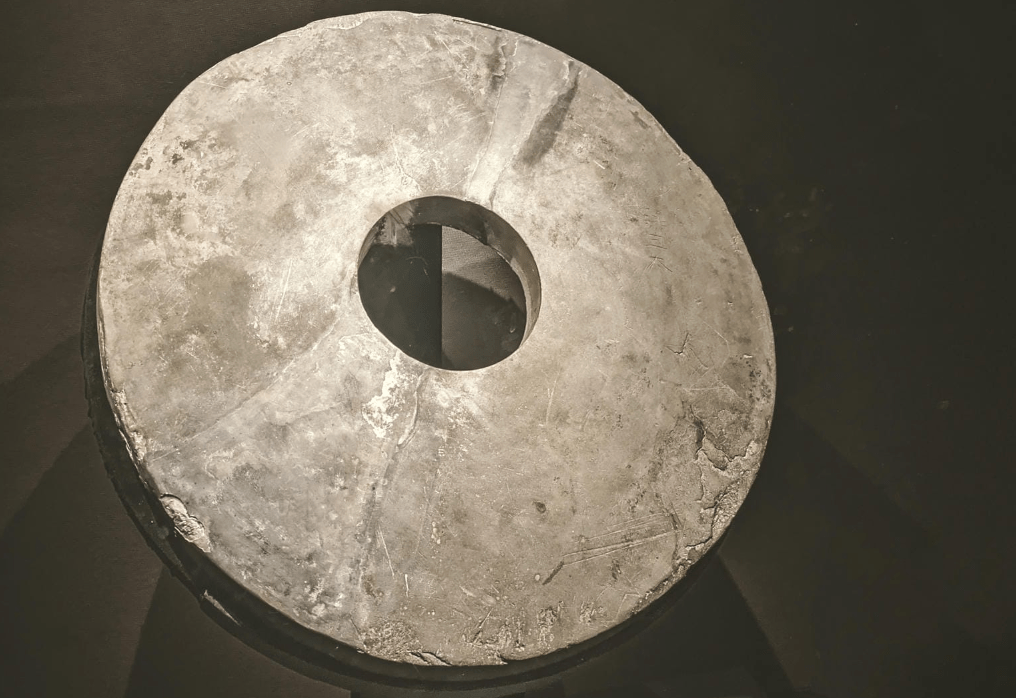
2. Bronze Figure
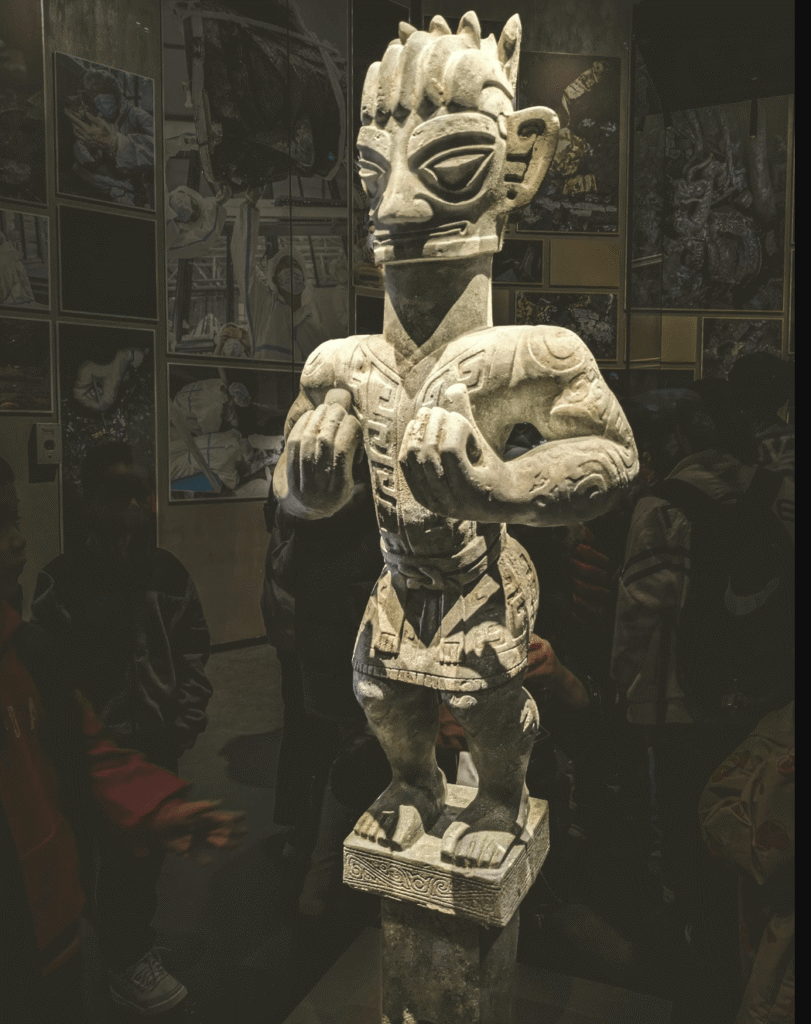
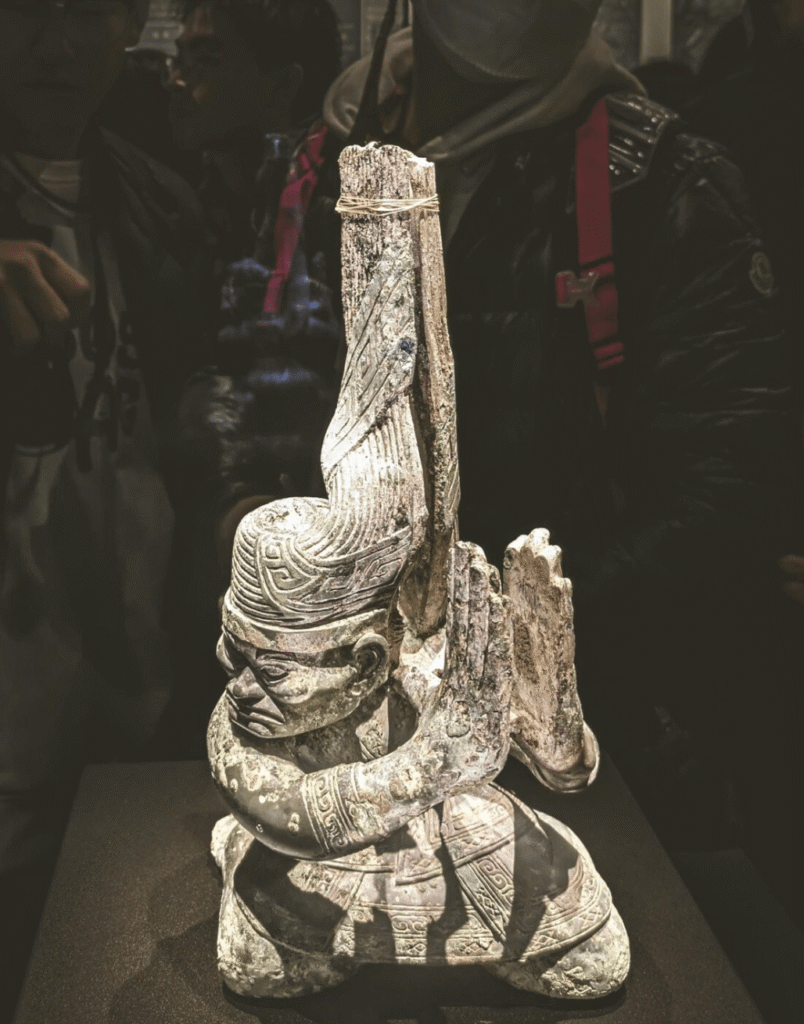
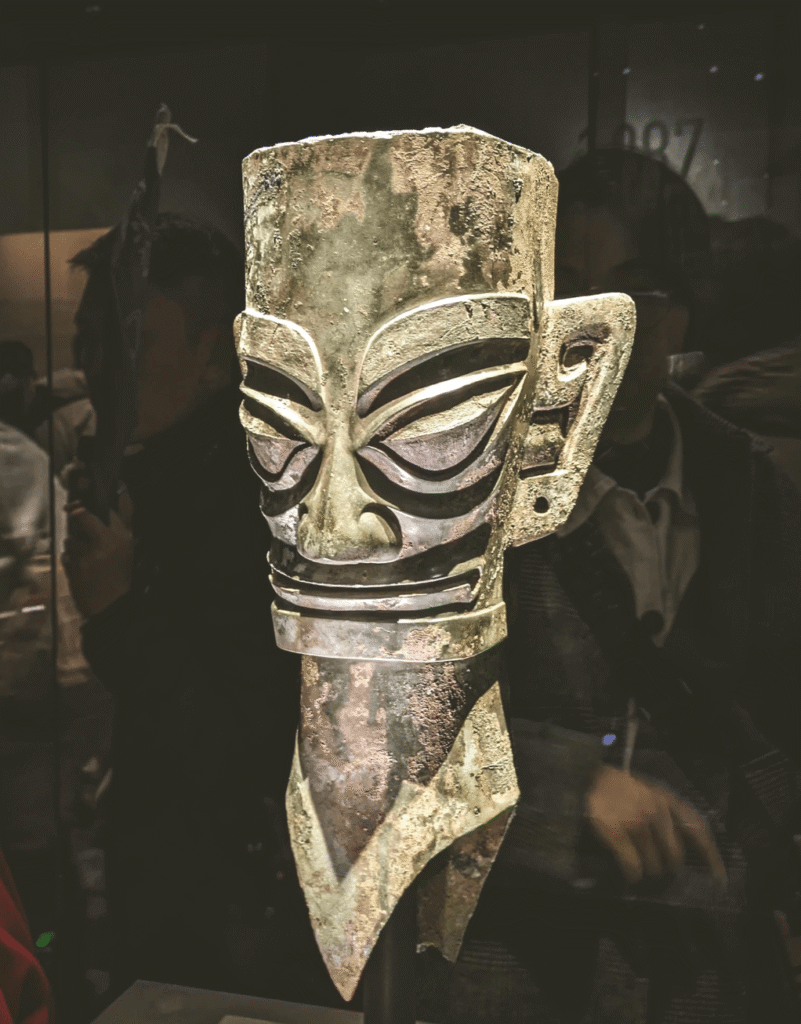
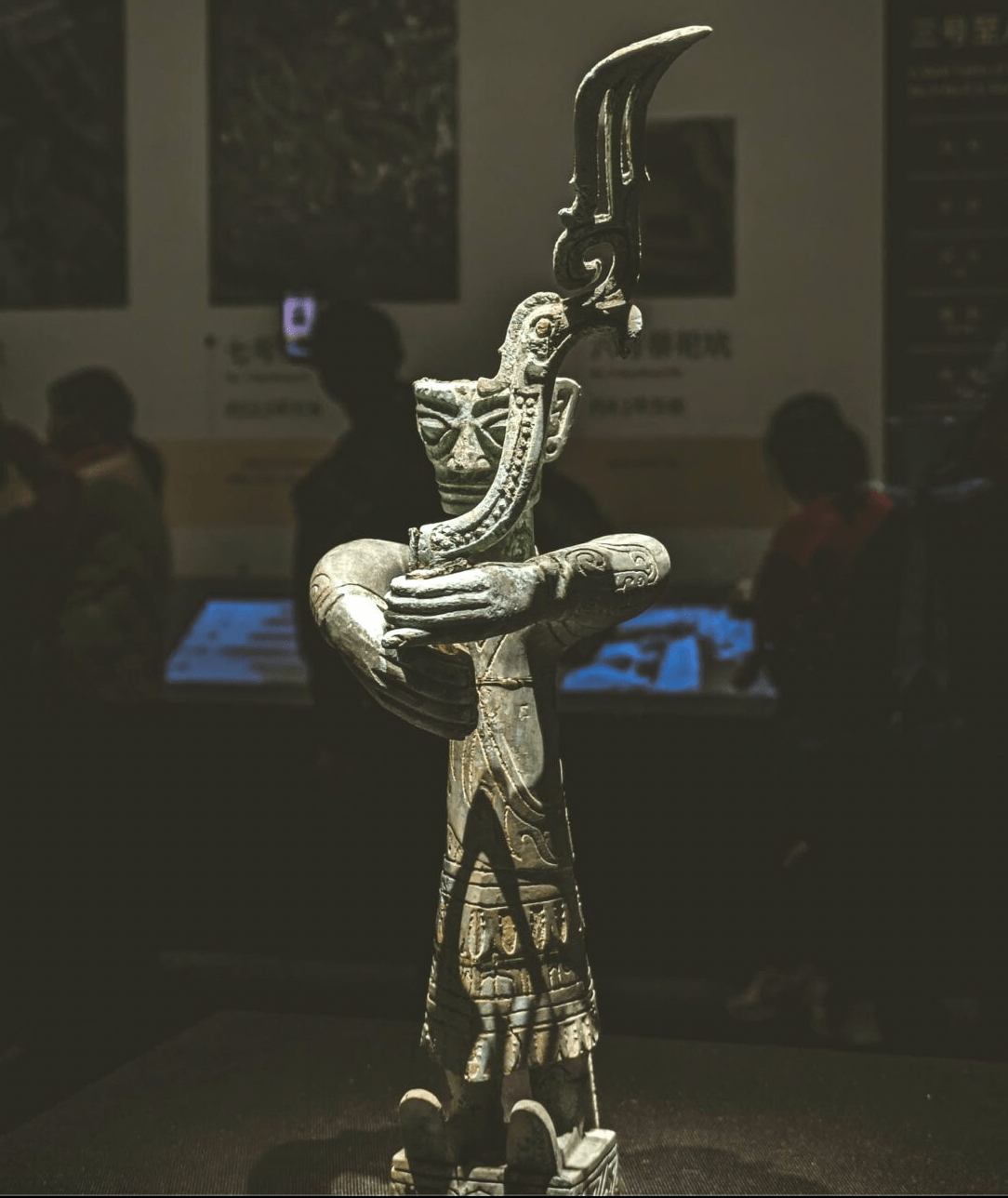
3. Golden bird-shaped ornament
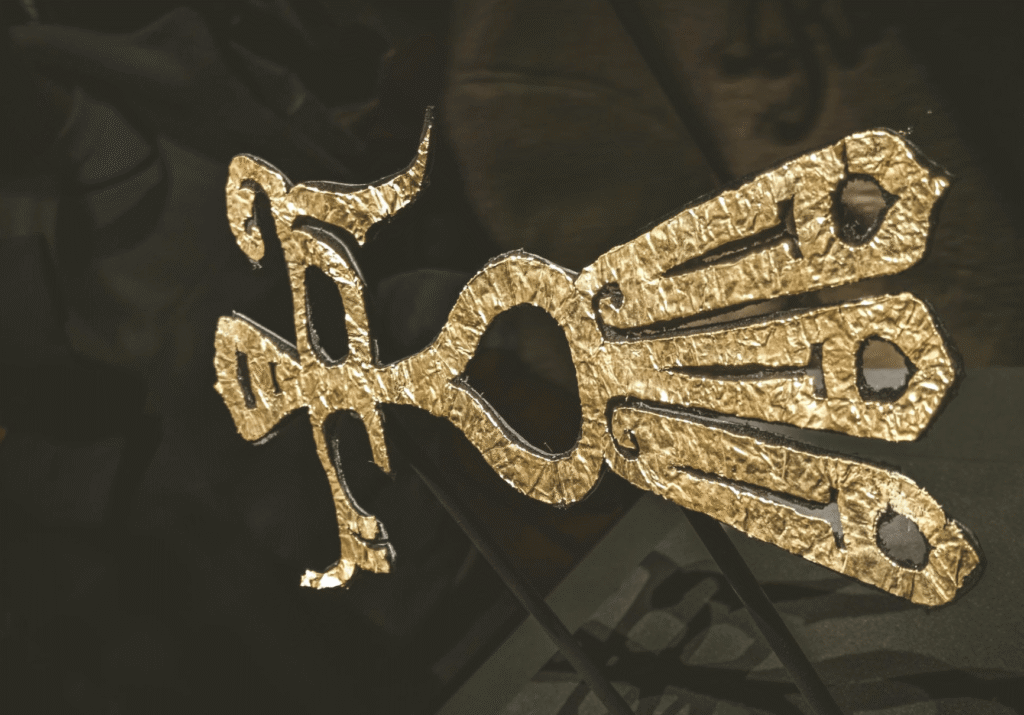
2. Weiran Wangdu
Location: 1st Floor Exhibition Area
Step into the “Weiran Wangdu” exhibition zone, and you’ll feel transported back to the ancient Shu Kingdom over 3,000 years ago. This section features detailed reconstructions of key ruins from the Sanxingdui site – including the palace complex, residential areas, and workshops – alongside numerous daily-use artifacts like pottery, stone tools, and bone objects. Through these displays, visitors gain vivid insights into the lifestyle, social structure, and handicraft mastery of the Shu people.
Artifacts on Display at Weiran Wangdu:
1. Gold Scepter
This 142cm-long ritual staff (c. 4000–3600 BCE), the world’s oldest gold scepter, showcases Sanxingdui’s unique kingship tradition. Adorned with engraved motifs—a human head, paired birds, and fish—it may represent Yu Fu, the legendary Shu king. The exquisite craftsmanship parallels ancient Egyptian royal symbols, redefining early Chinese metallurgy.
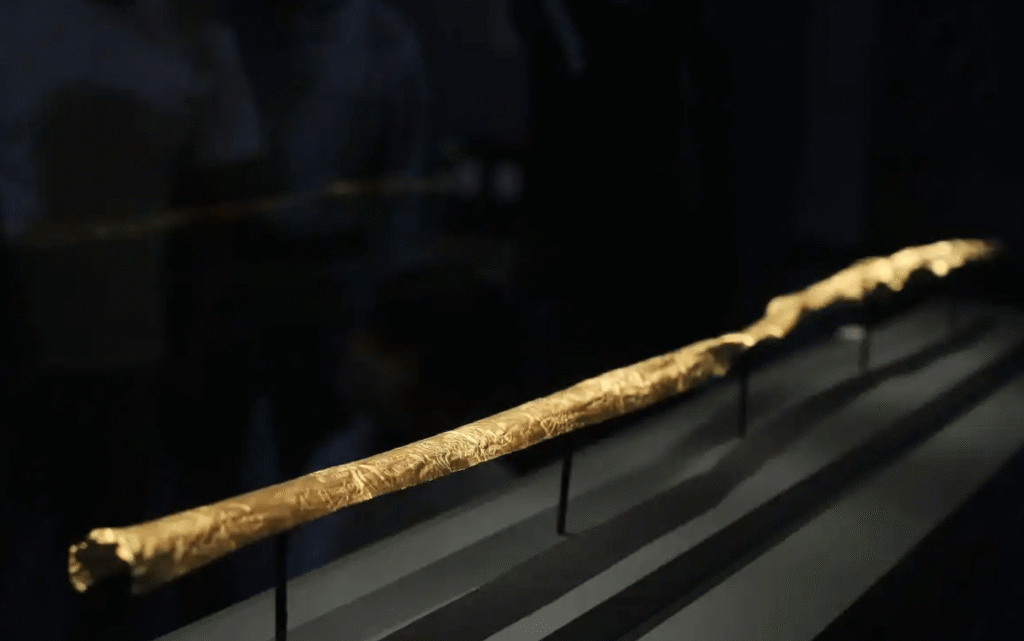
2. Tripod Pottery Cooking Vessel
This 44cm-high tripod pottery vessel, unearthed in 1986 at Sanxingdui, features a broad basin and hollow legs – a design allowing both cooking and ritual use. Its striking resemblance to modern Sichuan hotpot vessels has earned it the nickname “proto-hotpot,” suggesting the Shu people may have enjoyed communal cooking 3,000 years ago.
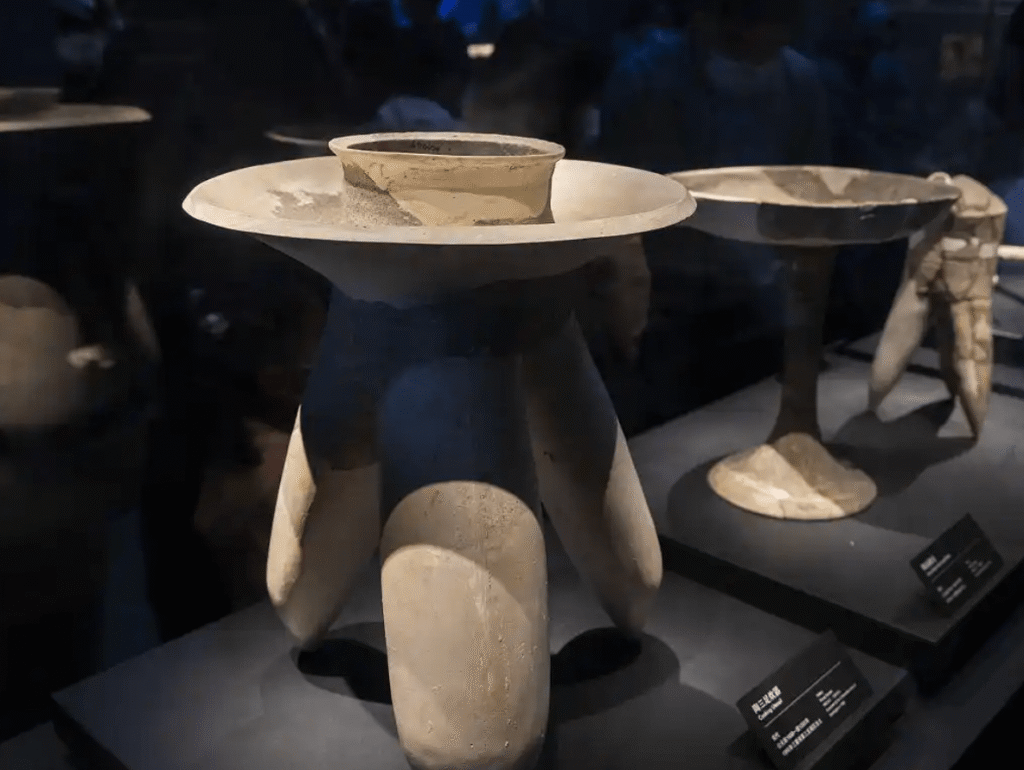
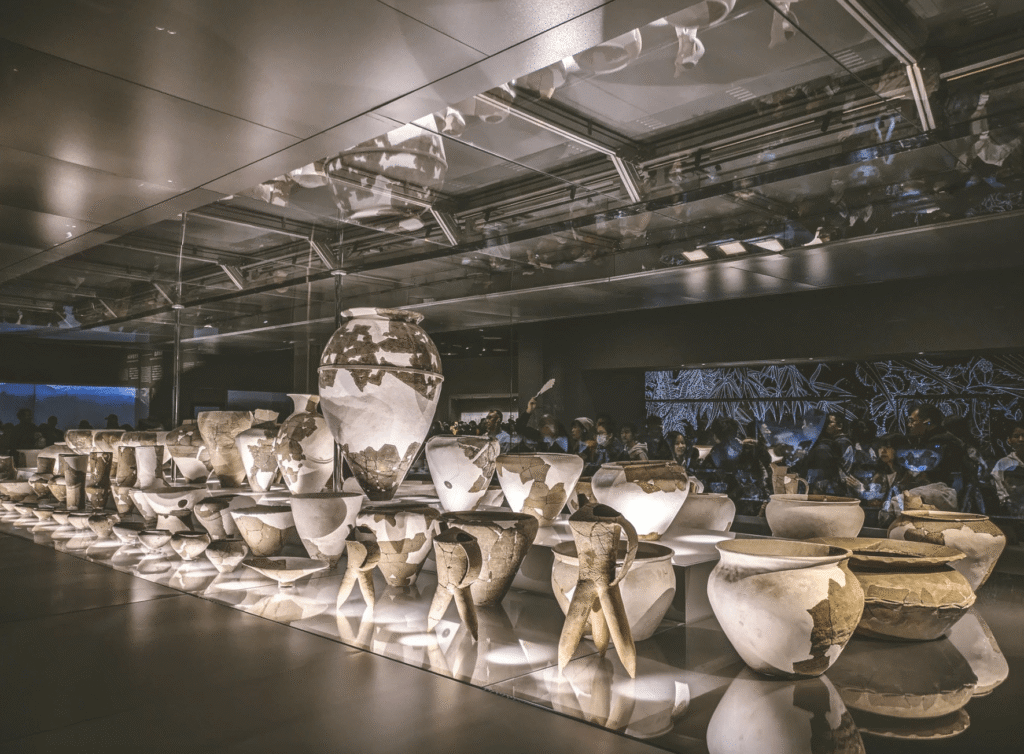
3. Pottery Human Figure & Pottery Pig
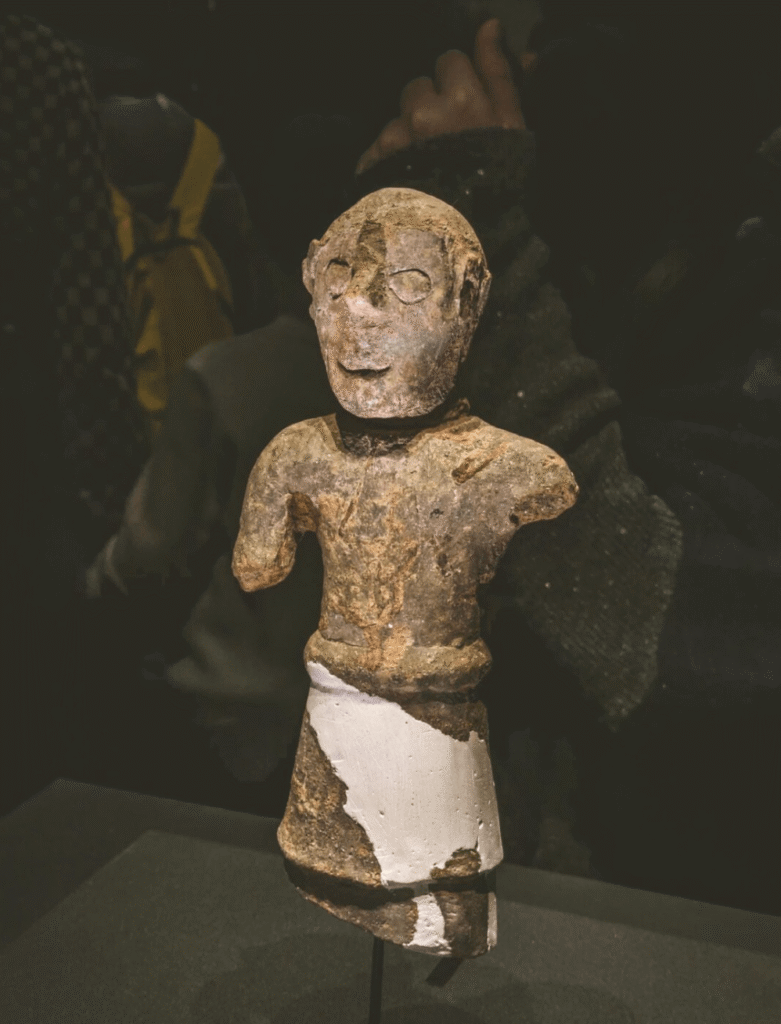
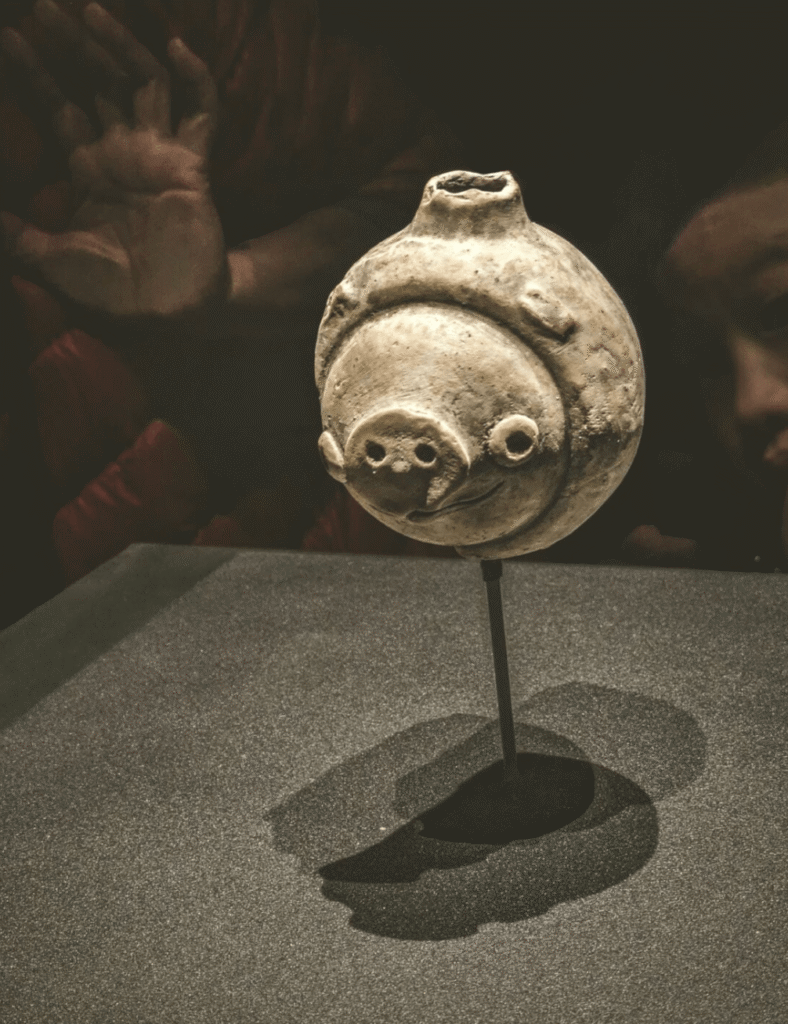
4. Bronze Human Head Figure
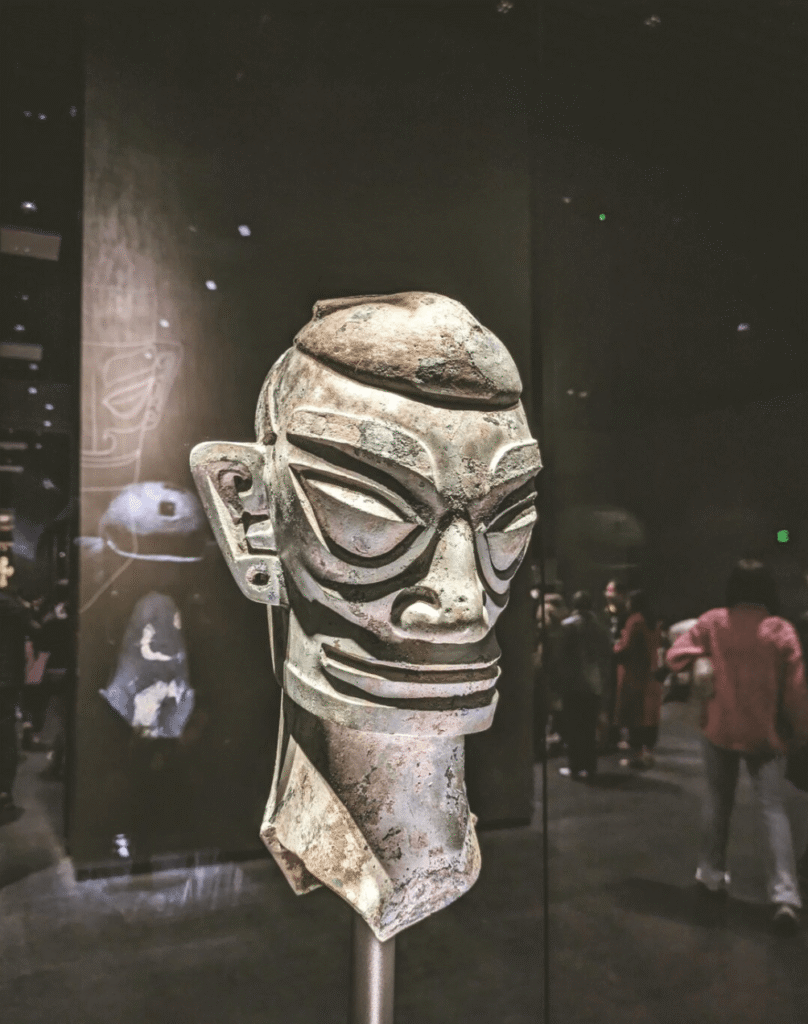
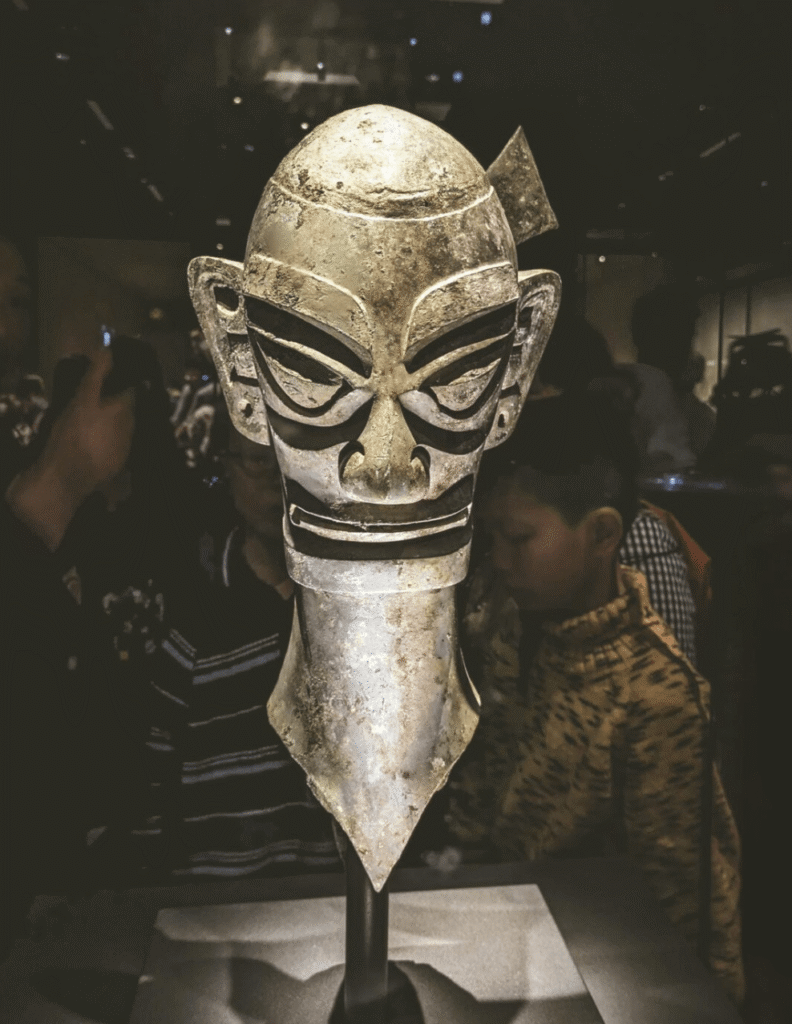
5. Bronze Large Standing Figure
From a worldwide point of view, Sanxingdui bronze large standing figure is also the largest bronze statue of the same period (261 cm tall). The statue is made by sectional casting. The body is hollow and is divided into two parts: the portrait and the base. The clothes are decorated with complex and exquisite patterns, mainly dragon patterns, supplemented with bird patterns, worm patterns and eye patterns, and square stripes on the body.
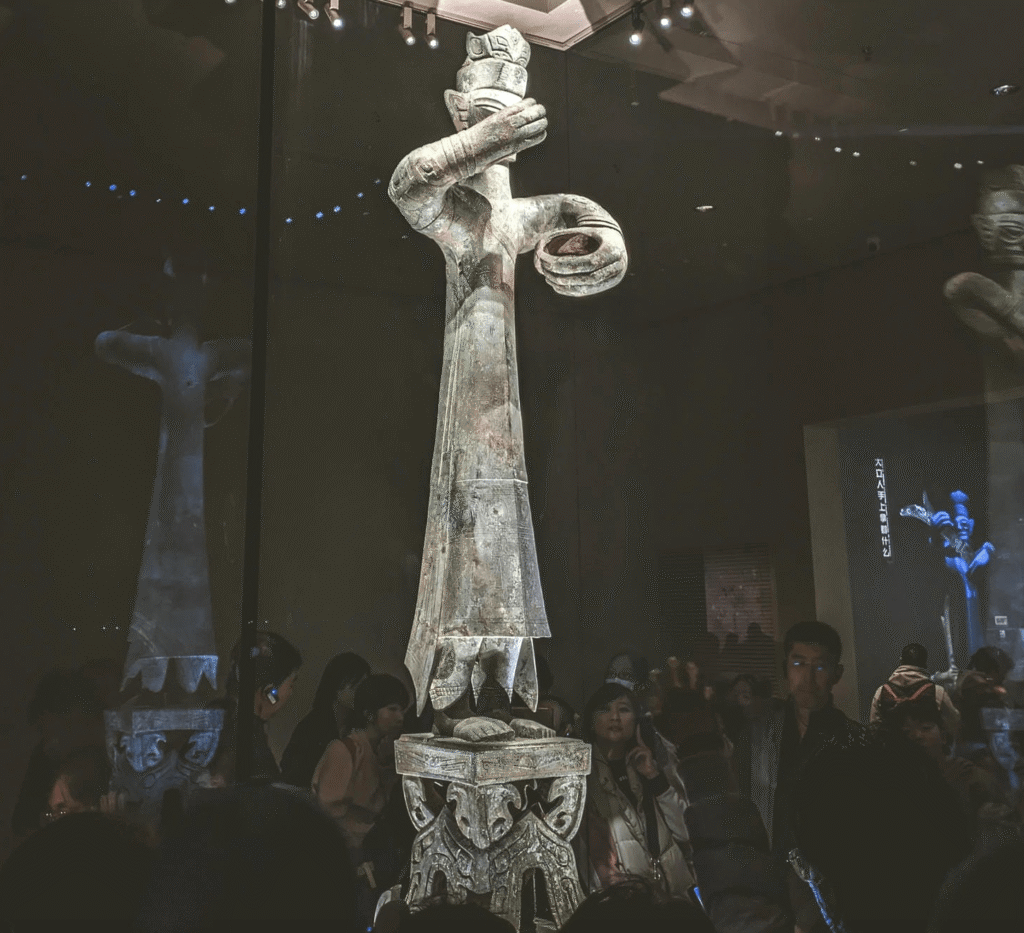
6. Gold Masks and Gold Foil Coverings
The gold masks and gold foil coverings unearthed at the Sanxingdui and Jinsha sites are believed to be associated with sacrificial activities, while gold masks found at other archaeological sites were primarily used to cover the faces of the deceased.
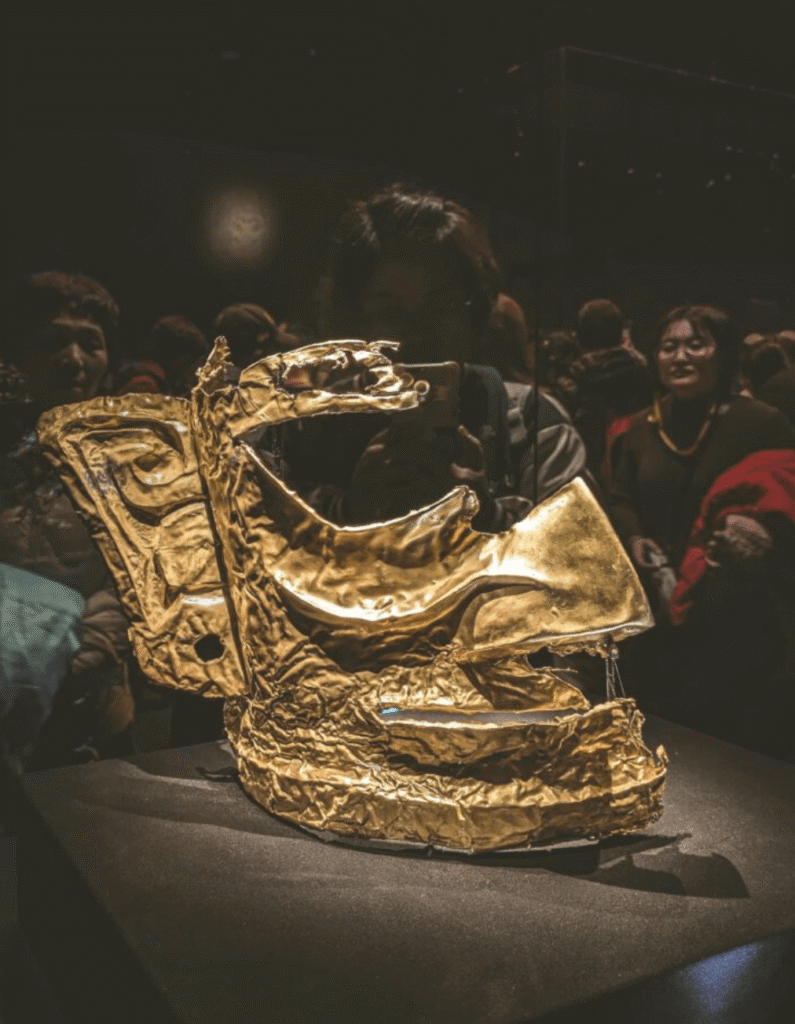
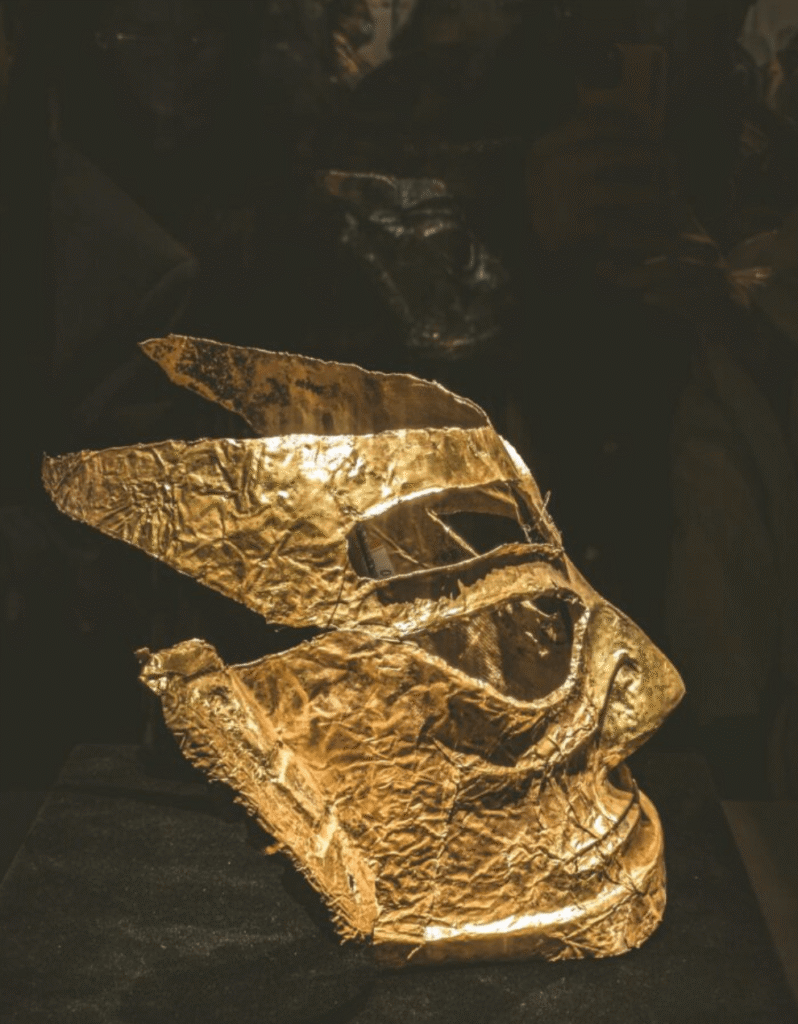
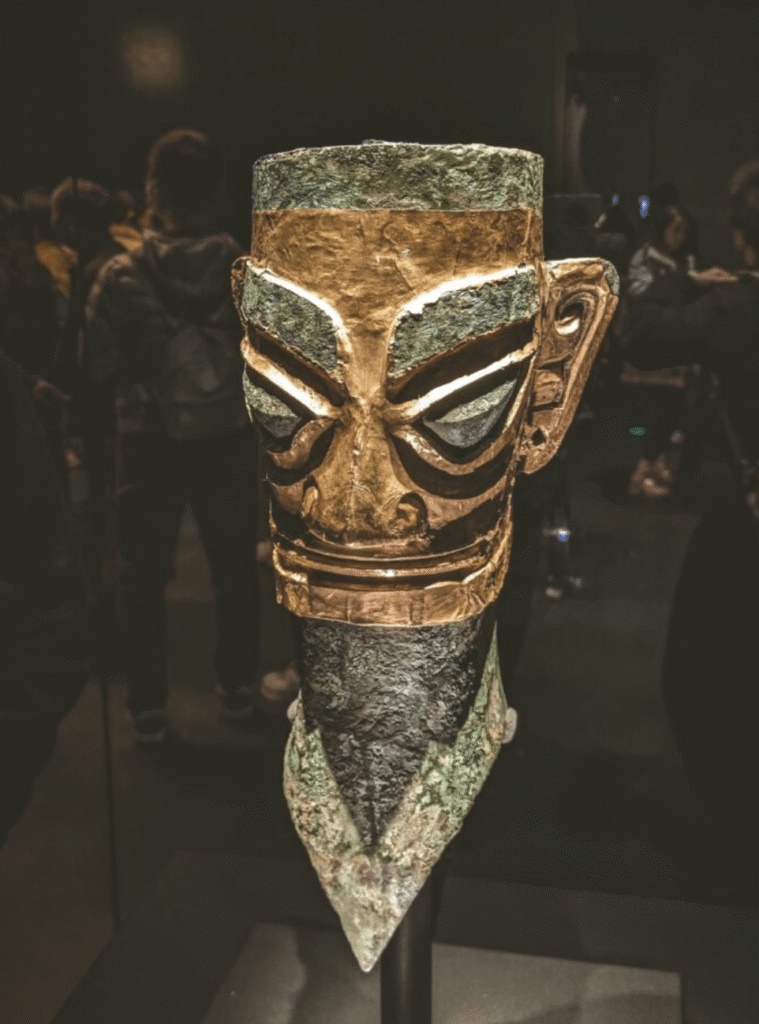
This gold foil is thin and accurately molded to fit a human face. It reflects the high level of craftsmanship achieved by the ancient Shu culture, with technical sophistication that rivals modern 3D printing.
7. The bronze zoomorphic vessel lid
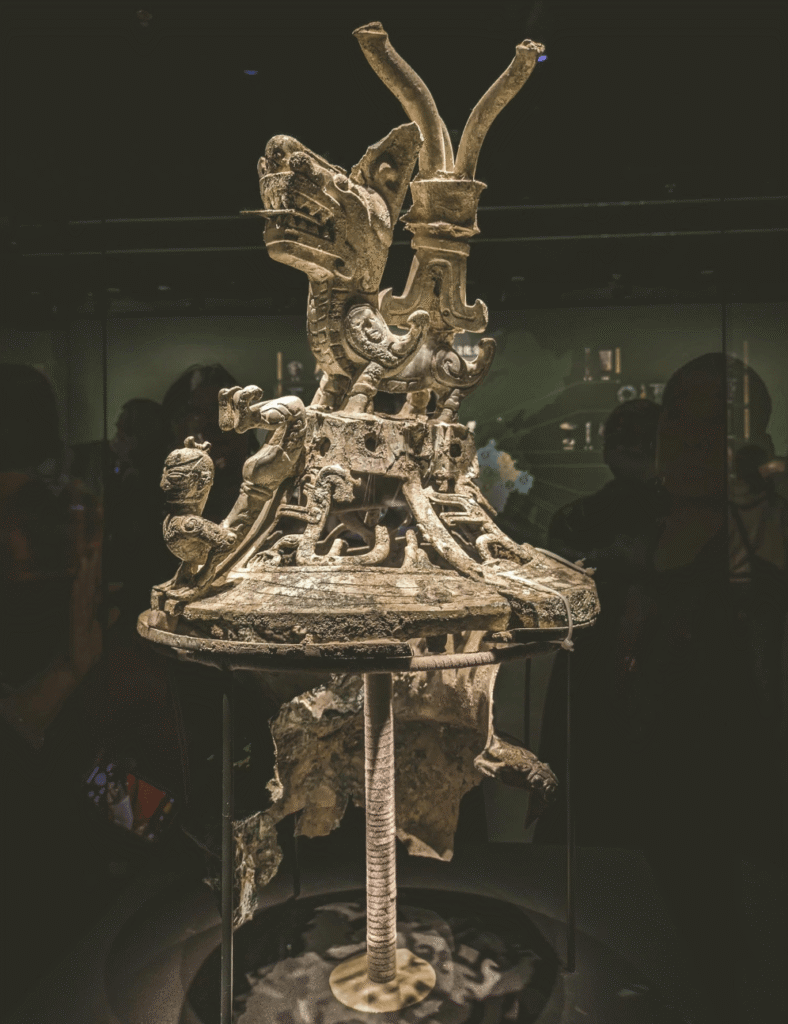
3. Heavenly, Earthly, Earthly, and Divine
Location: 2F Third Exhibition Area
This exhibition area displays the most representative bronze, jade, and gold artifacts unearthed from the Sanxingdui site, including the Shang Dynasty bronze sacred tree, Shang jade blade, Shang bronze standing figure, and Shang gold scepter. These artifacts amaze visitors with their unique shapes, exquisite craftsmanship, and profound cultural significance.
Artifacts on Display at this exhibition:
1. The Holy Bronze Tree
Among all the unearthed bronze wares unearthed from Sanxingdui site, this magnificent bronze tree represents the highest achievement of Bronze Age metallurgical art, it is also the biggest bronze tree found so far in China. Standing at 3.96 meters, Its nine spreading branches support twenty-seven fruits and nine sun-birds, while a sinuous dragon descends the trunk. The cosmic motif base, adorned with sun and cloud patterns, vividly expresses the Shu civilization’s sophisticated cosmology – integrating solar worship, nature veneration, and divine communication. As the largest complete bronze artifact from the ancient world, it spectacularly demonstrates the technical mastery and spiritual vision that characterized Sanxingdui’s unparalleled bronze-working tradition.
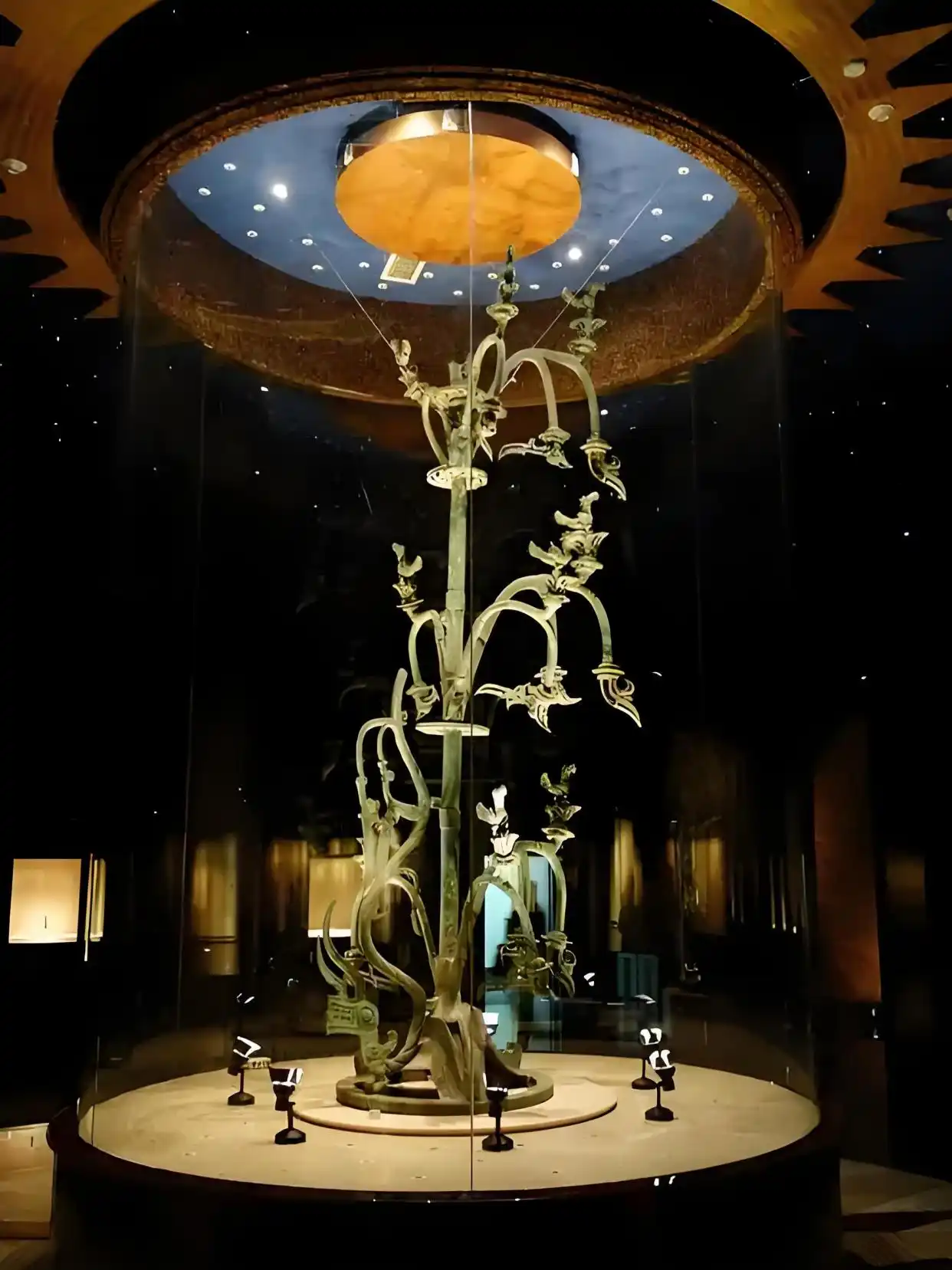
2. Bronze Vertical-eye Mask
Discovered in 1986 at Sanxingdui’s Pit No. 2, this monumental late Shang Dynasty mask (66cm tall × 138cm wide) is renowned for its extreme facial exaggerations. Its protruding cylindrical eyes (extending 16cm forward) and expansive ears earned it the nickname “Clairvoyant and Clairaudient” mask. The striking features – upturned sword-like eyebrows, curled nostrils, and enigmatic upturned lips with a slightly exposed tongue – suggest supernatural capabilities. A square forehead hole indicates possible lost ornamentation. As one of Sanxingdui’s two largest masks, its exaggerated proportions represent the Shu people’s unique artistic vision of divine power.
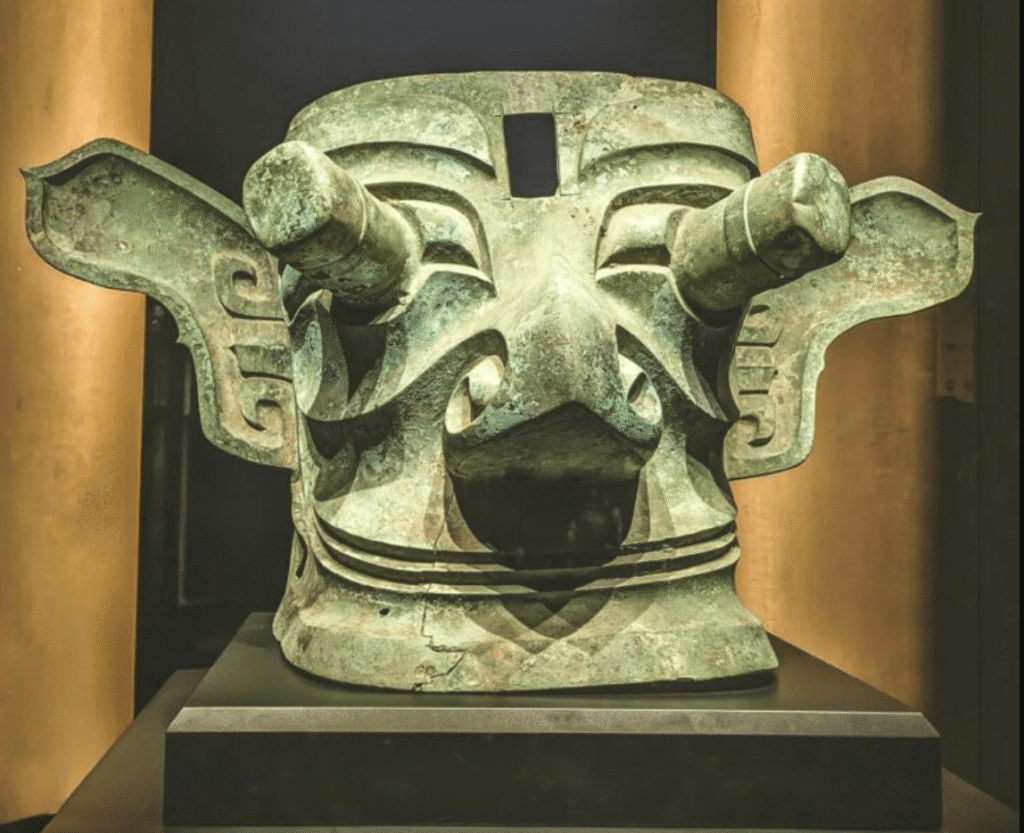
3. Sun-shaped Bronze Ritual Object
Unearthed from Sanxingdui’s Pit 2 (1986), this 85cm-diameter Shang ritual object features a convex central “sun” with five radiating spikes connecting to an outer ring. Its sophisticated two-stage casting (spikes+ring first, then sun-core) demonstrates advanced Bronze Age metallurgy. While debated as either a solar symbol (matching temple motifs), chariot wheel, or shield ornament, its perfect radial symmetry suggests sacred astronomical significance, possibly mounted in temples for solar worship before ritual destruction.
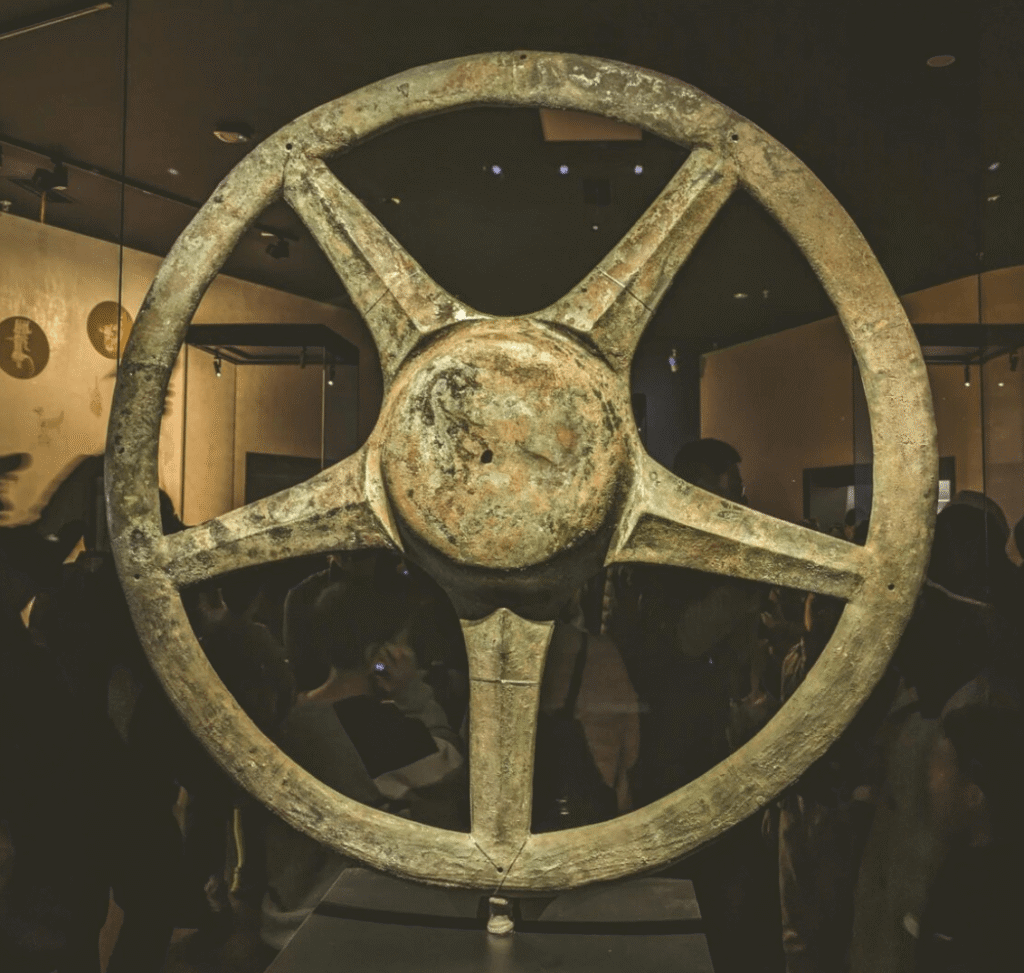
4. The Bronze Altar
Regarded as one of Sanxingdui’s most mysterious ritual artifacts alongside the Bronze Sacred Tree, this bronze altar was discovered in fragments – three damaged sets from Pit No.2 in 1986 requiring two years of meticulous reconstruction by archaeologists, with an additional specimen later unearthed from Pit No.8 in 2022. The altar’s sophisticated multi-level design, featuring miniature processional figures and mythical creatures, showcases extraordinary modular casting techniques while symbolically representing the Shu people’s cosmological worldview.
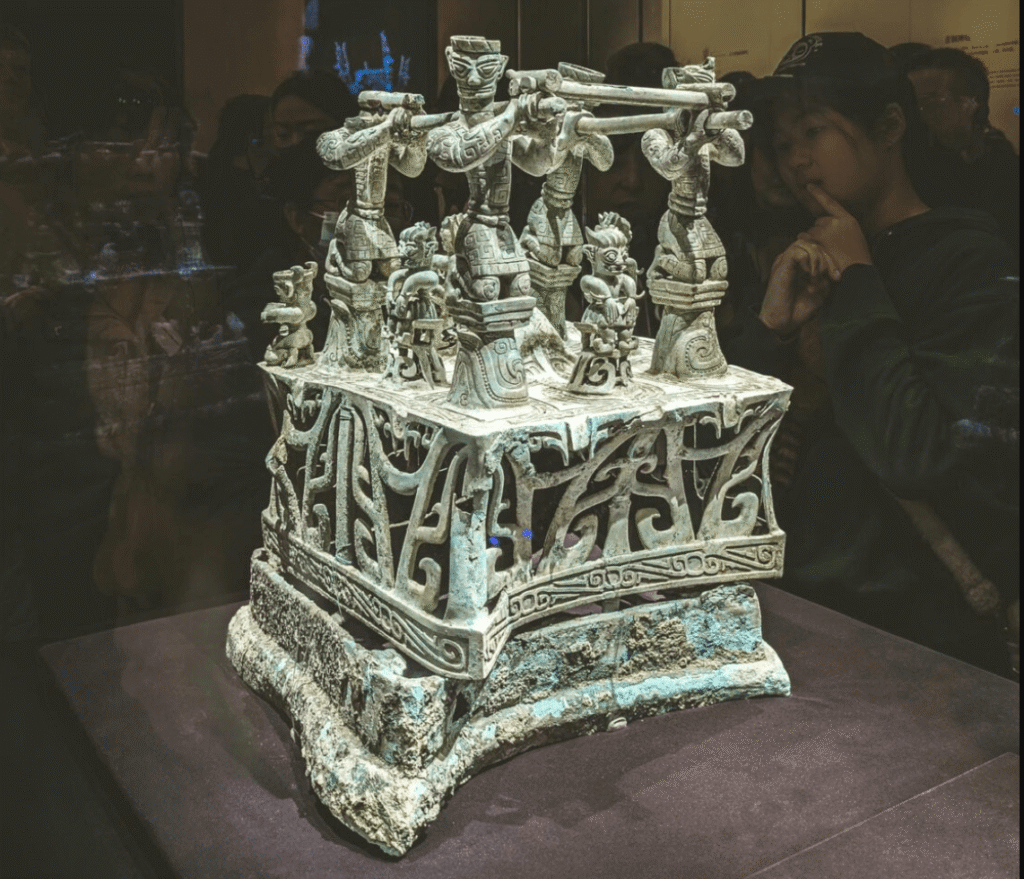
The Mysteries and Discoveries of Sanxingdui
Nestled along the northwest bank of the Yazi River in Guanghan, Sichuan, the Sanxingdui ruins have earned global renown as the “Ninth Wonder of the World.” This sprawling ancient site, gradually revealed through decades of meticulous archaeological work, continues to astonish scholars with each new discovery. While excavations have uncovered breathtaking artifacts that rewrite our understanding of early Chinese civilization, they have simultaneously spawned countless unanswered questions that deepen the site’s mystique.
1. Alien-Like Artifacts?
The bronze statues feature elongated noses, protruding eyes, and oversized ears—unlike any contemporaneous Chinese depictions. Some speculate connections to lost civilizations or even extraterrestrial influences, though scholars link them to the legendary King Cancong, described in texts as having “protruding eyes.”
2. The Disappearance
Around 3,000 years ago, the city’s treasures were ritually smashed, burned, and buried. Was it invasion, revolt, or a religious crisis? No written records explain its fall, unlike other ancient civilizations.
3. Global Connections?
Similarities to Mayan and Egyptian art—such as gold scepters and bird motifs—fuel theories of prehistoric cultural exchange. Yet, how did ivory from India and seashells from distant coasts reach inland Sichuan?
4. Lost Language
Pottery and gold sticks bear mysterious symbols. Are they proto-writing or mere decoration? If writing existed, why no documents survive?
5. Advanced Metallurgy
A 143cm gold scepter, wrapped in 0.2mm-thick foil, and bronze with phosphorus (unknown until 1669) suggest unparalleled skill. Did they inherit knowledge from older cultures?
Sanxingdui’s artistic brilliance and sudden demise remain puzzles. With each excavation, we uncover more questions than answers—making it one of archaeology’s greatest challenges.
Sanxingdui Museum Virtual Tour
Sanxingdui Museum’s digital exhibition brings its archaeological treasures to life online, allowing virtual visitors to explore the collection remotely through immersive 360-degree virtual tours that showcase iconic artifacts like the Bronze Sacred Tree and golden masks in stunning detail. The interactive platform features rotatable 3D models of key relics, augmented reality projections for experiencing artifacts at life-size scale, and multimedia content including excavation footage and expert commentary. Click here to experience Sanxingdui Museum Virtual Tour.
Best time to visit Sanxingdui Museum
The recommended time for visiting Sanxingdui Museum is 3-5 hours. The specific time can be adjusted according to personal interests and the depth of the visit. If you only take a quick look at the core exhibits, it takes 2 hours, and an in-depth visit (including manual explanation) takes 4-6 hours.
Visiting time recommendation
- Basic visit (2-3 hours): Suitable for tourists with limited time or who only want to understand the core exhibits, you can focus on visiting the bronze standing statue, golden staff and other treasures on the first floor of the exhibition hall.
- In-depth visit (3-5 hours): Recommended for most tourists, including a comprehensive visit to the exhibition hall and the restoration hall, and reserving time to watch special exhibitions.
- Complete experience with explanation (4-6 hours): If you choose manual explanation (about 1.5 hours in the museum, queuing takes 30 minutes to 2 hours) or third-party tour guide service (usually 2.5-3 hours), you need to reserve additional waiting and rest time. Note: the price for manual explanation is ¥400 (1-10 people) or ¥600 (11-20 people).
How to get to Sanxingdui Museum from Chengdu
The most convenient way to get to Sanxingdui Museum from Chengdu is to take a scenic area shuttle bus or high-speed rail and transfer to a bus.
- Take the high-speed rail from Chengdu East Station to Guanghan North Station (20 minutes), then transfer to Guanghan Bus No. 13 directly to Sanxingdui Museum.
- Take a tourist shuttle bus from popular spots like Chengdu Research Base of Giant Panda, Kuanzhai Alley or Chunxi Road directly to the museum.
Sanxingdui Museum Ticket Prices & Opening Hours
Book Sanxingdui Museum Ticket Now| Entrance Fee | CNY 72 Free for children under 1.3m (4.3 feet). |
| Opening Hours | Exhibition Hall: 8:30-18:00 (Ticketing stops at 17:00) Restoration Exhibition Hall: 9:00-17:00 |
Notice:
The Sanxingdui Museum closes annually on Chinese New Year’s Eve but otherwise remains open year-round (unless announced otherwise). During peak seasons—Golden Week, public holidays, and winter/summer vacations (January, February, July, August)—extended hours apply: 08:30–20:00 (last entry at 18:00).
Recommended Tours Combining Sanxingdui with Other Attractions
1. Sanxingdui + Jinsha Site (located in Chengdu)
Perfect for history lovers: Trace the evolution of Shu culture across 1,000 years. Compare Sanxingdui’s gold scepter (1200 BCE) with Jinsha’s gold crown (800 BCE), and explore their iconic bronze masks.
Pro Tip: Visit Sanxingdui first to see the older civilization, then Jinsha to witness its artistic legacy.
2. Chengdu Panda Base + Sanxingdui
Morning: Meet giant pandas at Chengdu Panda Base.
Afternoon: Marvel at Sanxingdui’s “alien-like” bronze heads.
Why it works: Both sites are in northern Chengdu (1.5hr transfer), offering a seamless blend of nature and history.